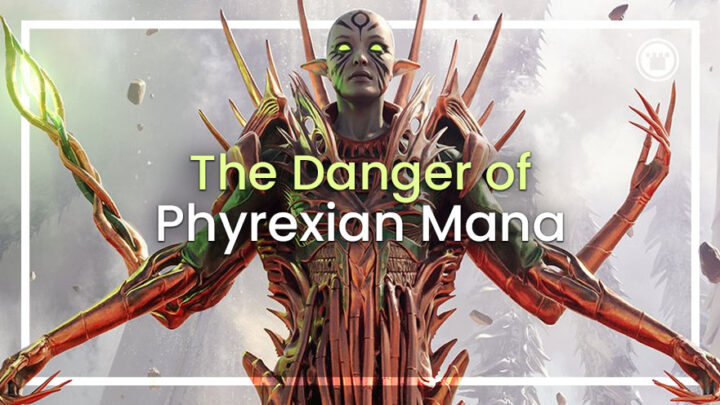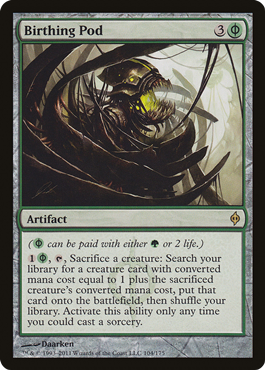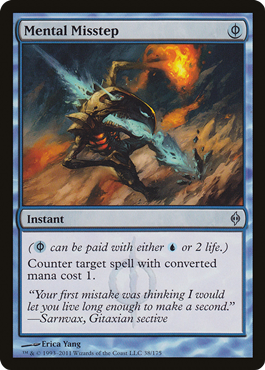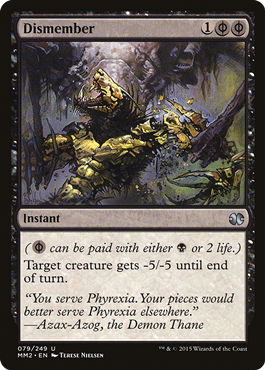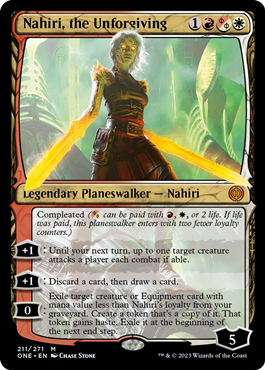Phyrexia: All Will Be One has shown us that New Phyrexia’s armies are filled with endless ranks of destructive, living weapons — but its most dangerous power remains its most simple: Phyrexian mana costs.
Introduced in 2011’s New Phyrexia, at the culmination of the Phyrexian invasion of Mirrodin, Phyrexian mana allowed players to pay for spells with chunks of life rather than colored mana. This almost immediately revolutionized every Constructed format, with an even greater impact on non-rotating formats where mana efficiency is more valuable.
Gitaxian Probe and Mental Misstep became so endemic they soon caught bans across multiple formats, while Birthing Pod was deemed too strong for Modern. This doesn’t even count cards like Mutagenic Growth, Gut Shot, Dismember, Vault Skirge, Noxious Revival, Spellskite, Surgical Extraction and Hex Parasite, which ranged from main deck playable to sideboard options across numerous decks.
And that doesn’t even touch the more niche applications of Phyrexian mana: Moltensteel Dragon was integral to the early-Commander powerhouse Scion of the Ur-Dragon, while Phyrexian Metamorph became a Vintage mainstay (with occasional Modern cameos).
After just one set, Magic players had seen all they needed to see of the Phyrexian mana mechanic, and it remained dormant until very recently. The only comparable mechanic in terms of metagame impact vs. cards printed is Storm, which is also — not coincidentally — the poster child for design gone wrong, according to Wizards of the Coast.
Wizards itself (or at least head designer Mark Rosewater, who popularized the “Storm Scale” evaluation of mechanics) most recently rated Phyrexian mana as a 9/10, meaning it “would take a minor miracle” for the mechanic to reappear in Standard… as it now has.
So, what precisely makes these mechanics so volatile? And why is Wizards potentially unleashing that volatility to print a new batch of Phyrexian mana cards?
Toxic By Design
The first problem with the original Phyrexian mana cards is obvious: a lot of them are simply too powerful by design. Any experienced player knows paying two life is virtually no cost at all, so you end up with a ton of spells that are an entire mana cheaper than expected. When the spell only costs one or two mana to begin with, or when lowering its cost speeds up your combo kill (as with Birthing Pod), that single saved mana elevates these cards far above their competition.
And that’s only considering the utility of their actual text. When you’re effectively printing a bunch of zero-mana spells, you have to consider how many decks will play them just to generate free bonus prowess triggers, storm count, cards-in-graveyard or card draw.
But Magic has endured periods of dominance by powerful cards or mechanics before, and many of them were longer or more complete than the pre-ban run of these Phyrexian mana cards. Ultimately, it was their lack of opportunity cost that really made them an omnipresent, metagame-warping force for evil.
Because these spells were effectively colorless as well as undercosted, Magic suddenly had a standardized suite of pushed, interactive spells that could be slammed into literally any deck. No matter what colors your opponent was on, you now had to play around your creatures dying to Dismember, your spells being countered by Mental Misstep or your win-con being exiled by Surgical Extraction — all at the same time.
And because many of them cost zero mana, that meant playing around all of them ALL the time! The only comparison for this universal impact are the pre-nerf Ikoria companions — but at least your opponent had to declare their companion at the start of a match!
The total lack of opportunity cost for playing Phyrexian mana cards, plus their unconditionally high power, created an entirely new mental burden that weighed on players throughout every single game. And that’s before you include the emotional impact of opening every game with a nerve wracking, multi-Mental-Misstep standoff.
Compleat Rethink
I can say without hyperbole that a repeat of that New Phyrexia experiment might kill competitive Magic (and seriously poison the well for casual play, besides). So you bet I was biting my nails as soon as Tamiyo, Compleated Sage was spoiled for Kamigawa: Neon Dynasty with those horrifying symbols on the card!
I was ready to launch into this tirade back then, but I decided to hold off… and I’m glad I did. Because even as Wizards of the Coast has extended this renaissance of Phyrexian Mana into Dominaria United, Commander precons and All Will Be One, those card designs have revealed a very different and more savvy approach to the mechanic.
None of the new Phyrexian mana spells are playable without colored mana. In fact, the two-color completed Planeswalkers still require access to both their colors of mana, even when the Phyrexian cost is being paid. In a lot of cases, the Phyrexian mana is used to pay for activated abilities, so it won’t ever impact your timing of or access to the spell itself.
The only cards that can be made cheaper are those planeswalkers, but reducing the cost of spells from five to four or four to three is much less frightening than going from one to zero. And you’re still forced to give up some of the planeswalker’s starting loyalty to make it a fair compromise.
This means the Phyrexian mana ends up more like a “modal” spell, with multiple viable options, rather than simply a cost reduction mechanic — which I’m sure we agree is a much more interesting outcome anyway.
A Newer, Safer Phyrexia
Phyrexian mana’s unlikely redemption arc reminds me of a recent post by occasional Wizards of the Coast consultant and commentator Patrick Sullivan. He argued, quite passionately, that even Storm itself had potential to be a perfectly safe and positive part of the game, if only card designers understood its constraints.
We may not have quite reached that level of enlightenment, but Wizards does seem to have figured out the next-worst thing on the Storm Scale. There are no instants or cantrips among the new Phyrexian mana cards to generate free value and no generic interactive or answer spells to be mass-adopted at the expense of the color pie or metagame diversity.
Wizards can never put the efreeti back in the bottle when it comes to the original Phyrexian mana spells, but the company is doing its best to show it has at least learned from its mistakes. So long as they continue to stick to proactive, sorcery speed cards with narrow usage and additional costs on their Phyrexian mana abilities, I believe this most dangerous and reviled of mechanics can yet be perfected.

Tom’s fate was sealed in 7th grade when his friend lent him a pile of commons to play Magic. He quickly picked up Boros and Orzhov decks in Ravnica block and has remained a staunch white magician ever since. A fan of all Constructed formats, he enjoys studying the history of the tournament meta. He specializes in midrange decks, especially Death & Taxes and Martyr Proc. One day, he swears he will win an MCQ with Evershrike. Ask him how at @AWanderingBard, or watch him stream Magic at twitch.tv/TheWanderingBard.

